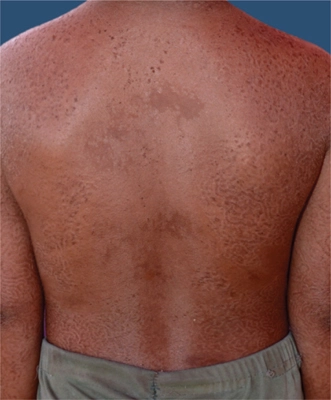Tinea Imbricata: An Overview

Background: Tinea imbricata is a chronic superficial mycosis caused mainly by Trichophyton concentricum. The condition mainly affects individuals living in primitive and isolated environment in developing countries and is rarely seen in developed countries. Physicians in nonendemic areas might not be aware of this fungal infection.
Objective: To familiarize physicians with the clinical manifestations, diagnosis, and treatment of tinea imbricata.
Methods: A PubMed search was completed in Clinical Queries using the key terms "Tinea imbricata" and "Trichophyton concentricum". The search strategy included meta-analyses, randomized controlled trials, clinical trials, observational studies, reviews, and case reports. The information retrieved from the above search was used in the compilation of the present article.
Results: The typical initial lesions of tinea imbricata consist of multiple, brownish red, scaly, pruritic papules. The papules then spread centrifugally to form annular and/or concentric rings that can extend to form serpinginous or polycyclic plaques with or without erythema. With time, multiple overlapping lesions develop, and the plaques become lamellar with abundant thick scales adhering to the interior of the lesion, giving rise to the appearance of overlapping roof tiles, lace, or fish scales. Lamellar detachment of the scales is common. The diagnosis is mainly clinical, based on the characteristic skin lesions. If necessary, the diagnosis can be confirmed by potassium hydroxide wet-mount examination of skin scrapings of the active border of the lesion which typically shows short septate hyphae, numerous chlamydoconidia, and no arthroconidia. Currently, oral terbinafine is the drug of choice for the treatment of tinea imbricata. Combined therapy of an oral antifungal agent with a topical antifungal and keratolytic agent may increase the cure rate.
Conclusion: In most cases, a spot diagnosis of tinea imbricata can be made based on the characteristic skin lesions consisting of scaly, concentric annular rings and overlapping plaques that are pruritic. Due to popularity of international travel, physicians involved in patient care should be aware of this fungal infection previously restricted to limited geographical areas.
Publisher URL: http://www.eurekaselect.com/node/169756/article/tinea-imbricata-an-overview
DOI: 10.2174/1573396315666190207151941
Keeping up-to-date with research can feel impossible, with papers being published faster than you'll ever be able to read them. That's where Researcher comes in: we're simplifying discovery and making important discussions happen. With over 19,000 sources, including peer-reviewed journals, preprints, blogs, universities, podcasts and Live events across 10 research areas, you'll never miss what's important to you. It's like social media, but better. Oh, and we should mention - it's free.
Researcher displays publicly available abstracts and doesn’t host any full article content. If the content is open access, we will direct clicks from the abstracts to the publisher website and display the PDF copy on our platform. Clicks to view the full text will be directed to the publisher website, where only users with subscriptions or access through their institution are able to view the full article.


